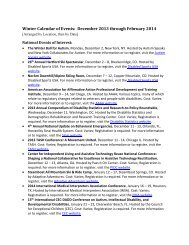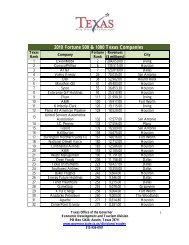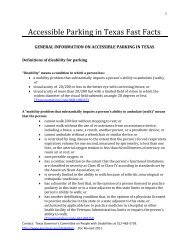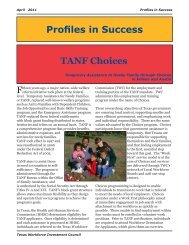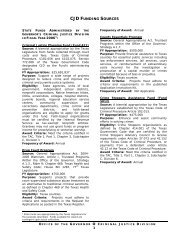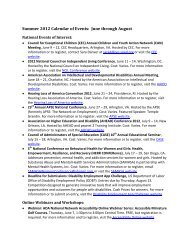People with Disabilities: A Texas Profile
People with Disabilities: A Texas Profile
People with Disabilities: A Texas Profile
You also want an ePaper? Increase the reach of your titles
YUMPU automatically turns print PDFs into web optimized ePapers that Google loves.
Regional Patterns<br />
Individuals <strong>with</strong> disabilities are not evenly distributed across the nation. The ACS summary data indicate<br />
that the South had the largest number of individuals <strong>with</strong> disabilities in 2011. The region <strong>with</strong> the<br />
second largest number of individuals <strong>with</strong> disabilities was the Midwest, followed by the West. The<br />
Northeast had the smallest number. The regional distribution of individuals <strong>with</strong> disabilities can be<br />
examined in more detail by reviewing the population of individuals <strong>with</strong> disabilities for each state.<br />
Appendix A contains a thematic map that illustrates the population of individuals <strong>with</strong> disabilities in<br />
each state. Table 1 uses the same data presented by the map in Appendix A to illustrate the ten states<br />
<strong>with</strong> the largest populations of individuals <strong>with</strong> disabilities in 2011. Generally, states <strong>with</strong> the largest<br />
populations also had the largest numbers of individuals <strong>with</strong> disabilities. States <strong>with</strong> the smallest<br />
populations had the smallest numbers of individuals <strong>with</strong> disabilities. <strong>Texas</strong> had the second largest<br />
number of individuals <strong>with</strong> disabilities of all the states. North Dakota, District of Columbia, and<br />
Wyoming had the fewest numbers of individuals <strong>with</strong> disabilities.<br />
Table 1: The Ten States <strong>with</strong> the Largest Populations of Individuals <strong>with</strong> <strong>Disabilities</strong>, 2011<br />
State<br />
Individuals<br />
<strong>with</strong><br />
<strong>Disabilities</strong><br />
Percent of<br />
Total<br />
Population<br />
California 3,749,792 10.1%<br />
<strong>Texas</strong> 2,906,416 11.5%<br />
Florida 2,420,035 12.9%<br />
New York 2,091,270 10.9%<br />
Pennsylvania 1,671,648 13.3%<br />
Ohio 1,517,210 13.3%<br />
Michigan 1,356,359 13.9%<br />
Illinois 1,317,307 10.4%<br />
North Carolina 1,257,117 13.3%<br />
Georgia 1,161,966 12.1%<br />
Table notes: 2011 ACS summary table data. Percentages represent the portion of the total civilian<br />
noninstitutionalized population <strong>with</strong> a disability in each state.<br />
Demographic Characteristics of the U.S. Population of Individuals <strong>with</strong> <strong>Disabilities</strong><br />
The population of individuals <strong>with</strong> disabilities in the U.S. can be better understood through an analysis of<br />
several key demographic variables. Generally, women are more likely to have a disability than men. The<br />
longer life expectancy of women may be a partial explanation of this association. Figure 2 illustrates that<br />
12.4 percent of women in the U.S. had a disability in 2011 compared to 11.9 percent of men.<br />
8 <strong>Texas</strong> Workforce Investment Council




